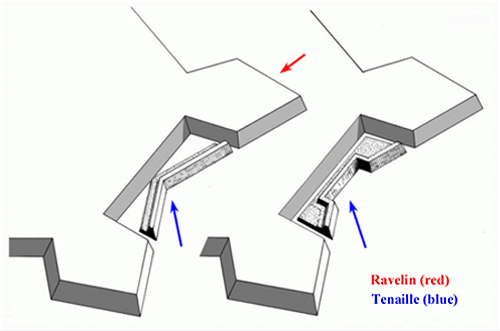
Return
A medieval tower afforded poor defense when
attacked with armies, especially armies using
cannons. Such towers made of bricks were good,
as bricks crumbled, while stone shattered.
However, defenders in such towers often could
aim at armies hidden behind the curvature of
these towers. These are "dead zones". The
situation only got worse as solid cannon balls
were replaced by explosive cannon projectiles.
Various methods of improving the design of
defensive fortresses were developed. A "glacis"
or deflective structure was developed to deflect
projectiles aimed at the base of fortress walls.
Moats were deveoped to keep attackers from easy
approach to fortress walls. Moats could contain
obstructions, not only water.
Earthen slopes were developed, in front of the
moats. These slopes forced attacking armies using
cannons to aim high. By lowering the height of
fortresses, these high-aiming projectiles did
less damage. Such projectiles might even have a
trajectory over the fortress. It took awhile to
develop mortars.
Diamond or star-shaped fortresses were developed.
Such star fortresses provided a method whereby
defenders of fortresses could reduce the area of
"dead zones". This was even more effective if
flanking fire from diamond shaped walls could
target beseiging cannons located upon the closest
location on the earthen slopes, just before the moat.
Interlocking lines of fire from different "stars"
was even more effective, as was the use of ravelins,
tenailles, combinations of tenailles with ravelins,
detached smaller fortresses, etc.

Star Fortress
© Copyright 2006 - 2018
The Esther M. Zimmer Lederberg Trust
 Website Terms of Use
Website Terms of Use